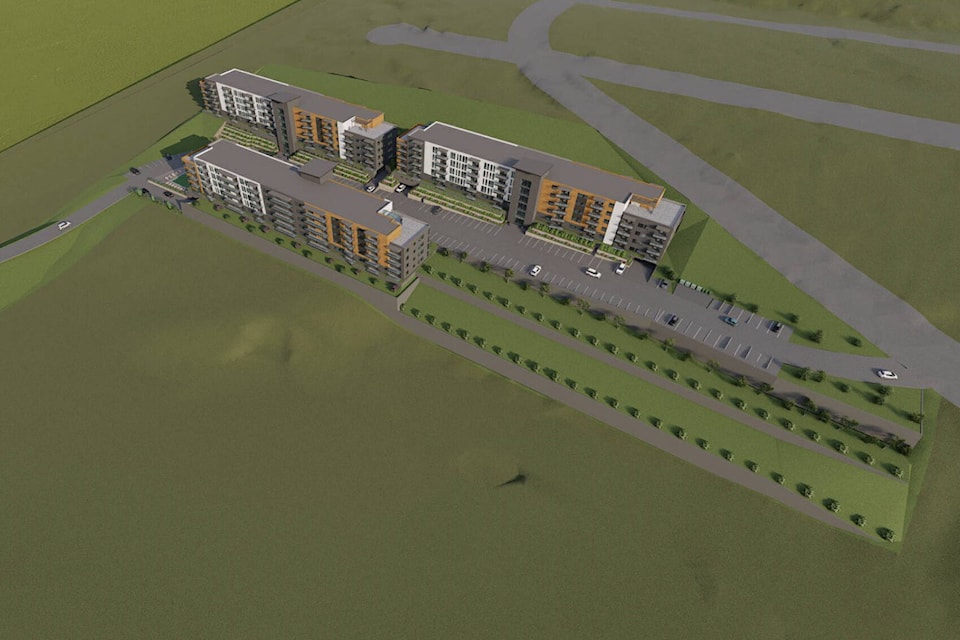After a long public hearing Monday night, Cranbrook city council passed third reading of planning and zoning amendments for a proposed apartment development off 30th Ave. north of the Park Royal neighbourhood.
City council voted 6-1 in favour of third reading, with Councillor Wayne Stetski casting the lone vote in opposition.
Mayor and council debated the proposal, posing various questions to staff on community planning, water consumption, traffic issues and more ahead of the vote.
Referencing the need for 1,400 housing units by 2031 as identified in the city’s latest housing needs report was a common theme from those who voted in favour of the proposal.
“As council, we need to consider the greater good of the community,” said Councillor Lynnette Wray, adding that increasing housing supply and options will help attract and retain new businesses and employees to the area.
Councillor Wayne Stetski, the lone vote against the proposal, cited his concerns with community planning.
“Should development drive our planning and our OCP [Official Community Plan], or should our OCP and planning drive development?” he asked, rhetorically. “And Cranbrook has a history — from my view and I’ve lived here for 34 years — of development driving planning and how our city ultimately looks in the end.”
“We need housing, absolutely, I’m just not sure this is the exact right spot for it.”
Mayor Wayne Price acknowledged that the proposal was one of the more difficult development decisions that city council has wrestled with in the last few years.
While some in the public hearing expressed a desire to see high density development closer to the downtown core, Price said the city can’t force landowners to develop their properties and that proposals tied to specific properties need to be judged on their merits.
“We do have land in the areas that people would like to see development, the city has no control over what we can make a landowner do or not do,” Price said.
The proposal by Westcor Lands Ltd. for the 30th Ave development includes three apartment buildings, each at five storeys in height with 92 units. Additionally, Westcor has committed to placing covenants on land that would only allow a seniors housing facility and a daycare site, to be run by non-profits.
All told, at full proposed buildout, the development would include 331 units.
Ahead of the debate, the public hearing went well over an hour, as nearby residents above and below the proposed site universally voiced their objections, with concerns ranging from slope stability, to safety issues caused by increased traffic, and the potential impact that a sudden increase of demand would have on the city’s infrastructure and water supply.
In response to questions from council regarding concerns about the impact on water supply, staff noted that from a water supply perspective, including the city’s water licenses, there is enough to accommodate between 40,000 to 50,00 residents.
That would include a need for future upgrades to water infrastructure systems to bring that capacity to residents, which the city is already planning for, according to Mike Matejka, Manager of Infrastructure Planning and Delivery.
The developer will be required to do a water study to ensure the property will be able to supply the development with water to ensure it can provide enough for consumption, fire control and identify any necessary infrastructure upgrades that the developer would be responsible for.
However, household water consumption isn’t the main driver of concern when it comes to water supply management, said Matejka.
“The summer outdoor water use and irrigation use is the major issue that the city is trying to tackle when it comes to droughts, not routine domestic household water use,” he said.
Later on in the same meeting, city council also approved changes to the outdoor water use and regulation bylaws that set out clearer guidelines for outdoor water use aimed at conservation.
While supply was one concern from the public hearing, one resident also noted water pressure issues in her household, raising concerns that the development would further strain water pressure in the neighbourhood system.
Other residents also spoke about their concerns with the building height impacting sightlines, the impact that construction would have on wildlife and avian habitat, and the neighbourhood fit of having a high-density development so far away from the downtown core.
